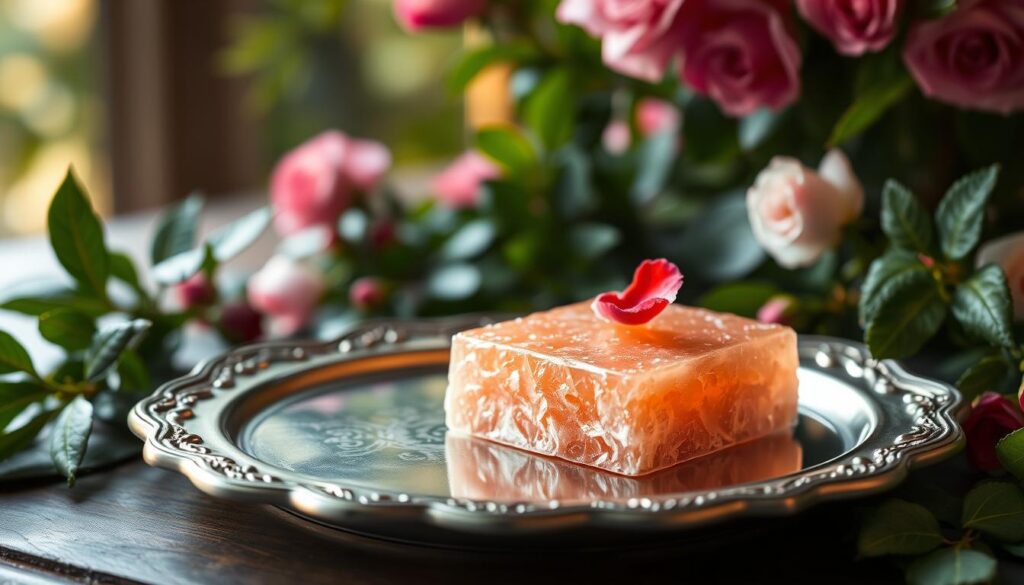We explore the fascinating role of Lokum, commonly known as Turkish Delight, in C.S. Lewis’s beloved classic, “The Lion, The Witch and The Wardrobe.” This sweet confection, made with starch and powdered sugar, serves as more than just a tempting treat in the story.
The magical version of this food offered by the White Witch to Edmund Pevensie represents one of literature’s most memorable examples of temptation and betrayal. The texture and appearance of this sugar-based treat made it the perfect vehicle for the Witch’s enchantment.
The cultural significance of Lokum enhances our appreciation of Lewis’s deliberate choice to use this specific confection. We examine how the temperature at which it’s served mirrors the cold emotional state of Edmund when he first encounters the White Witch.
Key Takeaways
- Turkish Delight serves as a symbol of temptation and betrayal in “The Lion, The Witch and The Wardrobe.”
- The cultural significance of Lokum adds depth to the narrative.
- The sugar-based treat’s texture and appearance made it ideal for the Witch’s enchantment.
- The temperature of the treat mirrors Edmund’s emotional state.
- Lokum’s role in the story reveals profound connections to biblical themes and moral instruction.
The Sweet Temptation in Narnia
The allure of the White Witch’s Turkish Delight is a potent symbol of the temptation that Edmund faces in the snowy woods of Narnia. This enchanted confection, made from a mixture of sugar, water, and enchantment, coated in powdered sugar, proves irresistible to Edmund, exploiting his vulnerabilities at a critical time.
Edmund’s First Encounter with the White Witch
Edmund’s initial meeting with the White Witch in the Narnian forest is a pivotal moment in the narrative. She strategically uses food as a tool for manipulation, offering him Turkish Delight when he is most susceptible – cold, confused, and isolated from his siblings. This act is a deliberate ploy to gain his trust and extract information about his family, ultimately leading to his betrayal.
The Magical Allure of the Enchanted Confection
The Turkish Delight offered by the White Witch is not just any ordinary treat; it’s a magical concoction designed to ensnare Edmund’s senses and willpower. The combination of its sweet taste and the Witch’s enchantment creates an irresistible allure, making Edmund crave more despite initial reservations. This episode illustrates how sugar-laden treats can be used to manipulate desires, highlighting the contrast between the Witch’s artificial sweetness and the wholesome food provided by other characters in the story, such as the Beavers.

What is Turkish Delight?
Turkish Delight, known as lokum in Turkish, has a rich history that spans centuries. This confectionery treat has captivated people worldwide with its unique texture and flavors.
Origins and Traditional Ingredients
The origins of Turkish Delight are deeply rooted in Ottoman culinary traditions. It was invented by Bekir Effendi in 1776 when he opened his confectionery shop in Istanbul. Traditional lokum recipes call for simple yet specific ingredients: sugar, water, starch (typically cornstarch), and flavorings like rosewater, lemon, or mint, all dusted with powdered sugar to prevent sticking.
| Ingredient | Purpose |
|---|---|
| Sugar | Provides sweetness and texture |
| Starch (Cornstarch) | Helps in creating the gel-like texture |
| Rosewater | Adds a distinct flavor and aroma |
| Powdered Sugar | Prevents sticking and adds sweetness |
Cultural Significance of Lokum
Lokum holds significant cultural value in Turkey and beyond. It is traditionally served with Turkish coffee, given as gifts during religious holidays, and used to symbolize hospitality in Turkish culture. The process of making lokum involves heating sugar and starch together until they form a thick, chewy consistency that sets at room temperature. Understanding the authentic nature of this sweet helps us appreciate why C.S. Lewis might have chosen it for his novel.

Turkish Delight in The Lion, The Witch and The Wardrobe
C.S. Lewis deliberately chose Turkish Delight as the treat that tempts Edmund in The Lion, The Witch and The Wardrobe, and this choice is rich in symbolism. The exotic nature of this confectionery, known as lokum in Turkish, would have been particularly enticing to British children during the post-war rationing period when sugar was scarce and foreign treats were rare luxuries.
The Author’s Deliberate Choice
We analyze why C.S. Lewis specifically chose Turkish Delight rather than any other candy or sweet for this pivotal plot element in The Chronicles of Narnia. The choice of Turkish Delight was likely due to its unique texture and flavor, which was both familiar and exotic to British readers.
The Witch’s Strategy
The White Witch uses the Turkish Delight not just as bait but as a tool for manipulation, creating a craving that clouds Edmund’s judgment and moral compass. The presentation of the Turkish Delight in an ornate box elevates its status from mere food to a precious gift, enhancing its allure.
Edmund’s Downfall
Edmund’s immediate addiction to the Turkish Delight represents how sin often begins with something that seems harmless or even pleasant but quickly leads to destructive behavior. The parallel between Edmund trading his family’s safety for Turkish Delight and Judas betraying Jesus for silver pieces creates a powerful biblical allegory about the true cost of betrayal.
Biblical Symbolism and Moral Lessons
Edmund’s temptation by the White Witch with Turkish Delight is a narrative device laden with biblical parallels, inviting a deeper exploration. The symbolism of sugar in this context represents temporary pleasure that leads to spiritual corruption, a recurring theme in The Chronicles of Narnia.
The Judas Parallel – Betrayal for Sweetness
Edmund Pevensie’s betrayal of Aslan for Turkish Delight mirrors Judas Iscariot’s betrayal of Jesus for thirty pieces of silver. This parallel is not coincidental; C.S. Lewis deliberately constructed this narrative to convey profound biblical teachings about sin and redemption in a child-accessible format. The White Witch’s offer of lokum (Turkish Delight) symbolizes the temptation tactics employed by Satan, offering immediate gratification in exchange for spiritual destruction.
| Biblical Element | Narnia Parallel | Moral Lesson |
|---|---|---|
| Judas’ Betrayal for Silver | Edmund’s Betrayal for Turkish Delight | The danger of prioritizing temporary gains over loyalty and integrity |
| Satan’s Temptation in the Wilderness | The White Witch’s Temptation of Edmund | The importance of resisting temptation to avoid spiritual corruption |
Temptation and Sin in Children’s Literature
C.S. Lewis masterfully uses the concrete example of Edmund’s craving for Turkish Delight to introduce complex ethical questions about loyalty, betrayal, and the consequences of giving in to temptation. This narrative approach makes profound biblical teachings accessible to young readers, providing a moral framework that is both understandable and relatable.
The Psychological Impact of Turkish Delight
In ‘The Lion, The Witch and The Wardrobe,’ the Turkish Delight is more than just a sweet treat; it’s a literary device used to delve into the complexities of human psychology. C.S. Lewis masterfully crafts the narrative to explore the psychological effects of indulgence and compulsion through Edmund’s experience with the enchanted lokum.
Addiction as a Literary Device
C.S. Lewis uses Edmund’s addiction to Turkish Delight as a sophisticated literary device to illustrate the psychology of temptation and compulsion. The physical effects of the enchanted lokum, including the sugar rush and subsequent crash, mirror the cycle of addiction that can develop with both substances and behaviors.
The Physical and Emotional Aftermath
The Turkish Delight, made from a mixture of sugar and water and enhanced by the Witch’s heat of enchantment, creates not just a physical but a psychological dependency. After consuming it, Edmund becomes irritable, secretive, and increasingly isolated from his siblings. The table below summarizes the psychological and physical effects of Turkish Delight on Edmund.
| Effects | Physical | Psychological |
|---|---|---|
| Sugar Rush | Temporary energy boost | Initial euphoria |
| Sugar Crash | Energy depletion | Irritability |
| Dependency | Craving for more | Secretive behavior, isolation |
By exploring Edmund’s experience with Turkish Delight, we gain insight into the psychological components of compulsive behavior and the enduring impact of temptation on human decision-making, regardless of the temperature or situation.
Making Your Own Narnia-Inspired Turkish Delight

With a few simple ingredients and some patience, you can bring the magical world of Narnia to your kitchen with homemade Turkish Delight. This traditional confection, known as “lokum” in Turkish, has captivated audiences since its introduction in C.S. Lewis’s The Lion, The Witch and The Wardrobe. Our recipe will guide you through creating this enchanting treat, capturing its essence without the White Witch’s enchantment.
Traditional vs. Modern Approaches
Traditional Turkish Delight requires careful temperature control, using a candy thermometer to reach the soft ball stage (around 240-250°F) for the perfect chewy texture. While modern recipes sometimes simplify this process by substituting gelatin for cornstarch, we will stick to the traditional method for an authentic experience.
Key Ingredients and Techniques
The critical mixture of sugar, water, and cornstarch creates the distinctive gel-like consistency of authentic Turkish Delight. To achieve this, combine sugar, citric acid, and water in a heavy-bottomed pot and whisk until the sugar is fully dissolved. Then, slowly pour in a cornstarch slurry while whisking non-stop. The mixture will thicken into a gel-like consistency. After cooking, the Turkish Delight must set at room temperature before being cut into cubes and generously coated with powdered sugar. Adding food coloring (traditionally red or pink) and flavorings like rosewater or lemon creates the classic appearance and taste reminiscent of Narnia.
The Enduring Legacy of Edmund’s Turkish Delight
The legacy of Edmund’s Turkish Delight endures, a testament to the power of C.S. Lewis’s storytelling and the timeless appeal of this traditional confection. We see how the Turkish Delight scene from The Lion, The Witch and The Wardrobe has become one of literature’s most memorable food moments, inspiring countless readers to seek out this powdered sugar-coated treat. The 2005 film adaptation brought renewed interest in Turkish Delight, with specialty candy shops reporting significant increases in sales of this traditional lokum in decorative box packaging.
Modern recipes have evolved, making this once-exotic candy more accessible to home cooks, with variations in food coloring and simplified cooking techniques that don’t require precise temperature control or cold water tests. As we savor these chewy, powdered sugar-coated gems, we’re reminded of the special occasion treat that Edmund found so irresistible, with its room temperature setting period adding to its luxury and rarity.


